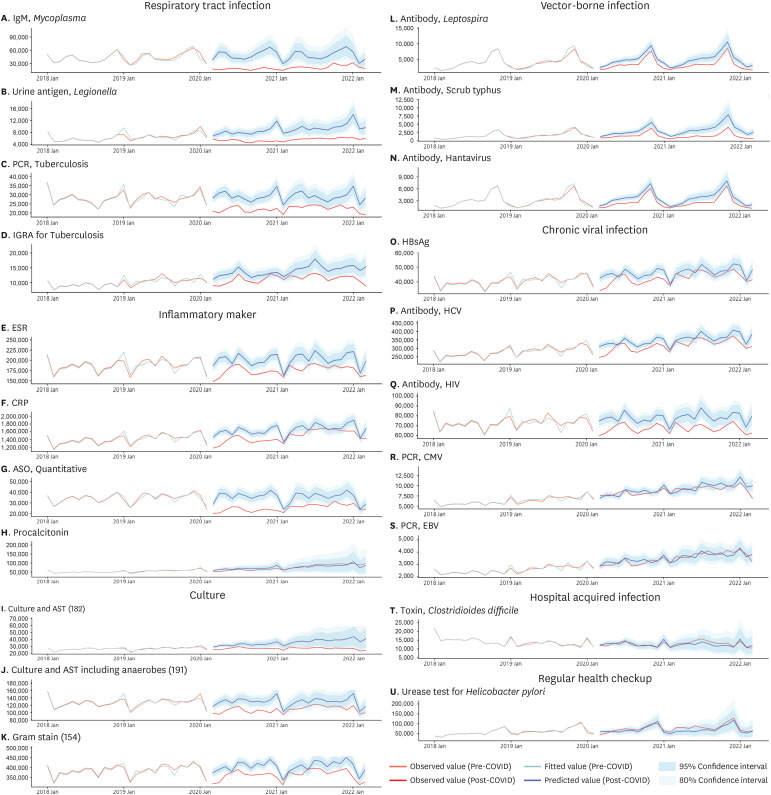J Korean Med Sci.
2023 Dec;38(47):e408. 10.3346/jkms.2023.38.e408.
Nationwide Trends in Non-COVID-19 Infectious Disease Laboratory Tests in the Era of the COVID-19 Pandemic in Korea
- Affiliations
-
- 1Department of Internal Medicine, Division of Infectious Diseases, Korea University College of Medicine, Seoul, Korea
- 2Department of Big Data Strategy, National Health Insurance Service, Wonju, Korea
- 3AI Product Team, Gmarket, Seoul, Korea
- 4Department of Preventive Medicine, Gachon University College of Medicine, Incheon, Korea
- 5Artificial Intelligence and Big-Data Convergence Center, Gil Medical Center, Gachon University College of Medicine, Incheon, Korea
- 6Division of Infectious Diseases, Department of Medicine, Samsung Medical Center, Sungkyunkwan University School of Medicine, Seoul, Korea
- 7Department of Laboratory Medicine, Severance Hospital, Yonsei University College of Medicine, Seoul, Korea
- KMID: 2548807
- DOI: http://doi.org/10.3346/jkms.2023.38.e408
Abstract
- The coronavirus disease 2019 pandemic has brought significant changes to infectious disease management globally. This study explored changes in clinical microbiological testing trends and their implications for infectious disease incidence and medical utilization during the pandemic. We collected nationwide claims for monthly clinical microbiology tests from January 2018 to March 2022 using the National Health Insurance Service database. Seasonal autoregressive integrated moving average models were employed to make predictions for each disease based on the baseline period (January 2018 to January 2020). The results showed a significant decrease in general bacterial and fungal cultures, respiratory infectious diseaserelated, and inflammatory markers, while the representatives of tests for vector-borne diseases, healthcare-associated infections, and chronic viral infections remained stable. The study highlights the potential of clinical microbiological testing trends as an additional surveillance tool and offers implications for future infectious disease management and surveillance strategies in pandemic settings.
Figure
Reference
-
1. Downey LE, Gadsden T, Vilas VD, Peiris D, Jan S. The impact of COVID-19 on essential health service provision for endemic infectious diseases in the South-East Asia region: a systematic review. Lancet Reg Health Southeast Asia. 2022; 1:100011. PMID: 35769109.
Article2. Min KD, Kang H, Lee JY, Jeon S, Cho SI. Estimating the effectiveness of non-pharmaceutical interventions on COVID-19 control in Korea. J Korean Med Sci. 2020; 35(35):e321. PMID: 32893522.
Article3. Yang B, Huang AT, Garcia-Carreras B, Hart WE, Staid A, Hitchings MD, et al. Effect of specific non-pharmaceutical intervention policies on SARS-CoV-2 transmission in the counties of the United States. Nat Commun. 2021; 12(1):3560. PMID: 34117244.
Article4. Geng MJ, Zhang HY, Yu LJ, Lv CL, Wang T, Che TL, et al. Changes in notifiable infectious disease incidence in China during the COVID-19 pandemic. Nat Commun. 2021; 12(1):6923. PMID: 34836947.
Article5. Wang P, Xu Y, Su Z, Xie C. Impact of COVID-19 pandemic on influenza virus prevalence in children in Sichuan, China. J Med Virol. 2023; 95(1):e28204. PMID: 36217691.
Article6. Huh K, Kim YE, Ji W, Kim DW, Lee EJ, Kim JH, et al. Decrease in hospital admissions for respiratory diseases during the COVID-19 pandemic: a nationwide claims study. Thorax. 2021; 76(9):939–941. PMID: 33782081.
Article7. Huh K, Jung J, Hong J, Kim M, Ahn JG, Kim JH, et al. Impact of nonpharmaceutical interventions on the incidence of respiratory infections during the coronavirus disease 2019 (COVID-19) outbreak in Korea: a nationwide surveillance study. Clin Infect Dis. 2021; 72(7):e184–e191. PMID: 33150393.
Article8. Yun HE, Ryu BY, Choe YJ. Impact of social distancing on incidence of vaccine-preventable diseases, South Korea. J Med Virol. 2021; 93(3):1814–1816. PMID: 33079384.
Article9. Kim DH, Nguyen TM, Kim JH. Infectious respiratory diseases decreased during the COVID-19 pandemic in South Korea. Int J Environ Res Public Health. 2021; 18(11):6008. PMID: 34205018.
Article10. Shi HJ, Kim NY, Eom SA, Kim-Jeon MD, Oh SS, Moon BS, et al. Effects of non-pharmacological interventions on respiratory viruses other than SARS-CoV-2: analysis of laboratory surveillance and literature review from 2018 to 2021. J Korean Med Sci. 2022; 37(21):e172. PMID: 35638198.
Article
- Full Text Links
- Actions
-
Cited
- CITED
-
- Close
- Share
- Similar articles
-
- The Management of Thyroid Disease in COVID-19 Pandemic
- Tracheostomy in the Era of COVID-19 Pandemic
- COVID-19 and Fungal Infection
- Food service industry in the era of COVID-19: trends and research implications
- Epidemiological changes in infectious diseases during the coronavirus disease 2019 pandemic in Korea: a systematic review


